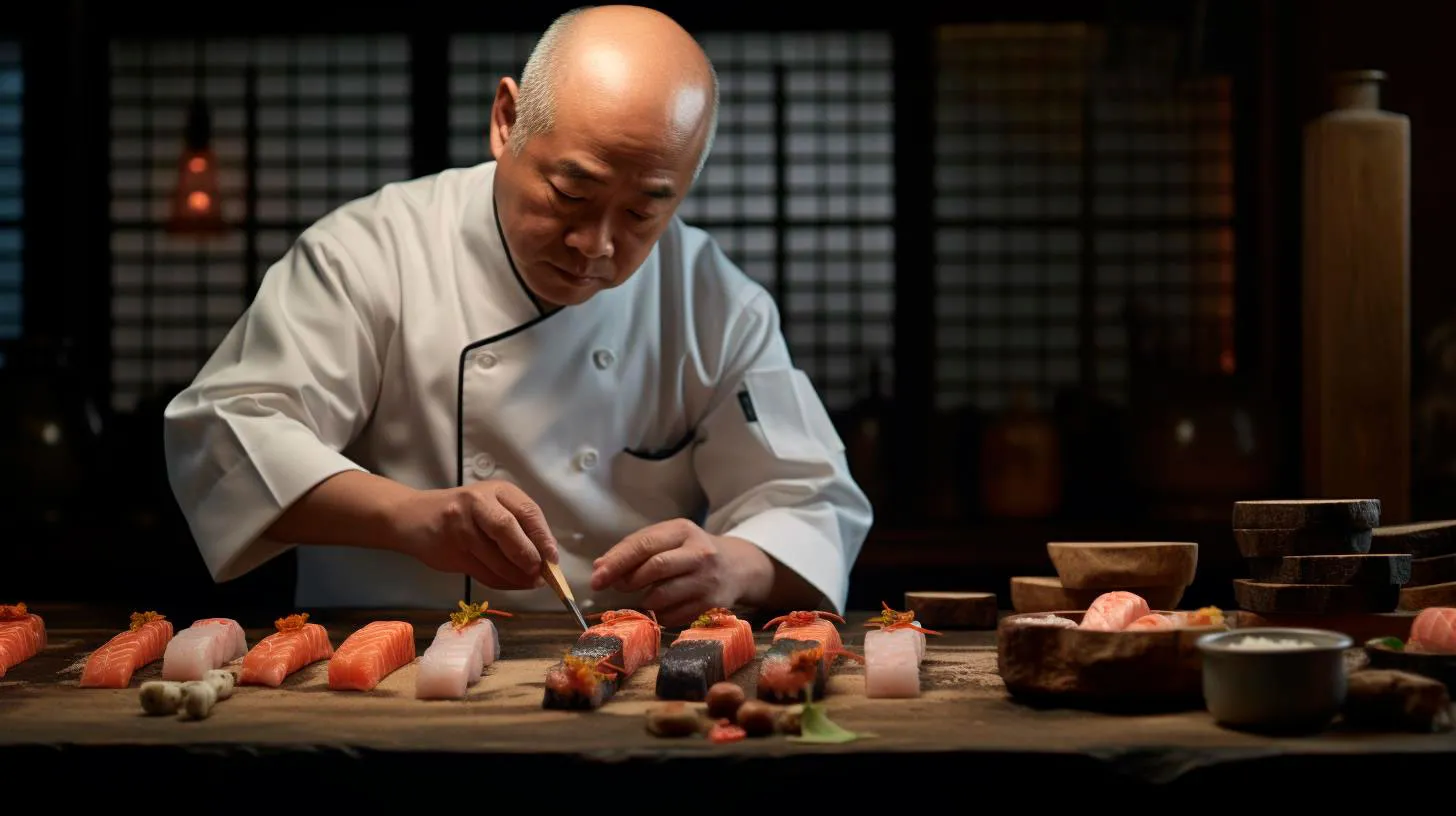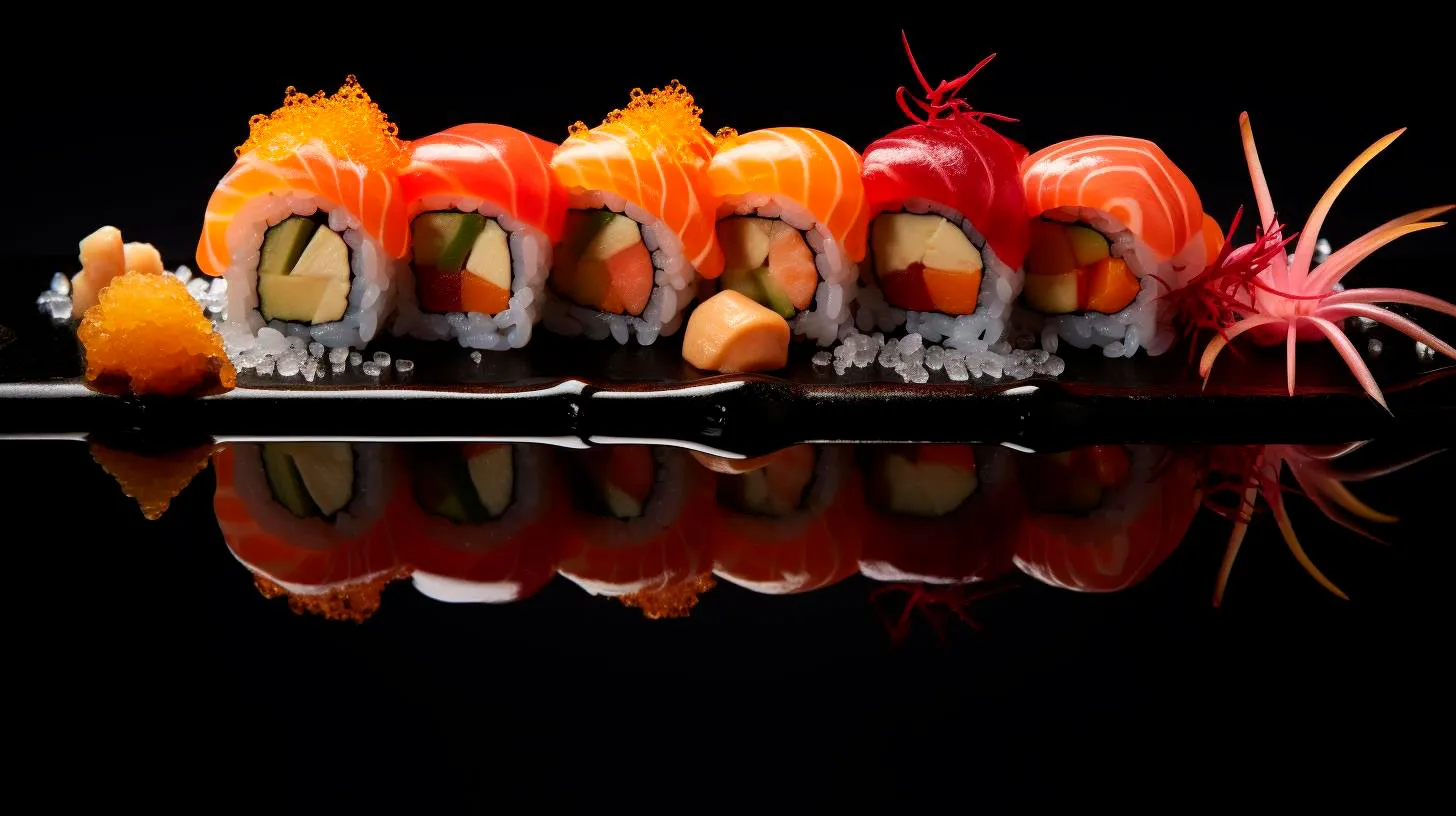Exploring Kyoto Renowned Sushi Restaurants
The Unique Sushi Culture in Kyoto
Kyoto, the cultural capital of Japan, is renowned for its traditional temples, stunning gardens, and picturesque streets. The city’s rich history and traditional values have greatly influenced its sushi culture. Unlike the fast-paced sushi counters in Tokyo or the trendy sushi joints in Osaka, Kyoto’s sushi restaurants focus on simplicity, elegance, and seasonal ingredients.
While Kyoto may not be home to the famous Tsukiji Fish Market, it boasts an abundance of fresh local ingredients such as Ayu (sweetfish), Saba (mackerel), and Ebi (shrimp). Chefs in Kyoto take great pride in sourcing these local delicacies, resulting in sushi that showcases the flavors and essence of the region.
Key Features of Kyoto Sushi Restaurants
When venturing into Kyoto’s sushi scene, you can expect the following key features to enhance your dining experience:
- Omakase style: Omakase, meaning “chef’s choice,” is a common practice in Kyoto sushi restaurants. Instead of ordering à la carte, you let the skilled chef create a personalized course for you, showcasing the freshest seasonal ingredients.
- Breathtaking presentation: Kyoto chefs pay great attention to detail, not only in the flavor of the sushi but also in its presentation. Each sushi piece is arranged meticulously, resembling a work of art.
- Seasonal flavors: Kyoto’s sushi restaurants embrace the concept of “shun,” which refers to the idea of eating food during its peak season. This ensures that you savor the perfect flavors of each ingredient.
- Authentic atmosphere: Many of Kyoto’s sushi restaurants are traditional machiya-style buildings, often located in charming neighborhoods. These establishments provide an authentic and tranquil setting, allowing you to appreciate both the sushi and the surroundings.
Renowned Sushi Restaurants in Kyoto
1. Sushi Matsumoto
Sushi Matsumoto is a hidden gem tucked away in the historic Gion district. With only counter seating for eight guests, this intimate sushiya offers an exceptional dining experience. Chef Matsumoto’s precise techniques and selection of premium ingredients make his sushi creations truly remarkable. The seasonal nigiri courses are complemented by a warm and welcoming atmosphere.
2. Sushi Zen
Located in the heart of Kyoto near the Nishiki Market, Sushi Zen is a Michelin-starred restaurant known for its traditional Edomae sushi. The skilled chef, using seasonal ingredients sourced directly from Tsukiji Market, crafts each piece with utmost precision. The restaurant’s elegant ambiance and extensive sake menu add to the overall experience.
3. Ichimonji
Ichimonji, situated in the bustling Shijo-Karasuma area, is a sushi restaurant renowned for its focus on aburi (lightly seared) sushi. This unique cooking technique enhances the flavors of the fish, resulting in a delightful combination of textures. Ichimonji’s modern and stylish setting provides a comfortable environment to indulge in this exquisite style of sushi.
Advantages of Kyoto Sushi Restaurants
By exploring Kyoto’s renowned sushi restaurants, you can enjoy several advantages:
- Experience traditional and authentic sushi techniques passed down through generations.
- Savor the freshest seasonal ingredients unique to Kyoto.
- Appreciate the meticulous craftsmanship of sushi presentation.
- Immerse yourself in the tranquil and historic atmosphere of Kyoto.
- Expand your palate with Kyoto’s unique sushi specialties, like ayu or saba nigiri.
In conclusion, although Kyoto may not be the first city that comes to mind when thinking of sushi, its sushi culture offers a distinct and memorable experience. The combination of seasonal ingredients, artistic presentation, and serene ambiance elevate the sushi dining experience to a whole new level. So, if you find yourself in Kyoto, don’t miss the opportunity to explore the renowned sushi restaurants that this enchanting city has to offer.
History and Evolution of Sushi in Kyoto
In this article, we will take a closer look at the history and evolution of sushi in Kyoto, highlighting its distinctive features, advantages, and key takeaways.
The Origins of Sushi
Sushi, as we know it today, has come a long way from its humble origins. The roots of sushi can be traced back to 7th century Japan when fishermen stored fish in fermented rice to preserve it for extended periods. The rice acted as a natural preservative, preventing the fish from spoiling. This early form of sushi, known as narezushi, was not consumed immediately but served after a few months.
Over time, sushi evolved, and in the 17th century, Hanaya Yohei, a chef in Edo (now Tokyo), revolutionized the dish by creating nigiri sushi. This style of sushi consisted of bite-sized pieces of vinegared rice combined with fresh fish toppings. The simplicity of this new sushi style made it more accessible and popular among the masses.
Sushi Culture in Kyoto
As we delve into the history of sushi in Kyoto, it becomes evident that the city has a unique sushi culture of its own. Kyoto, once the capital of Japan, has always been known for its traditionalism and adherence to cultural practices. Similarly, sushi in Kyoto follows a traditional approach, focusing on preserving authenticity and artistry.
Kyoto-style sushi, often referred to as Kyo-zushi, emphasizes the quality of ingredients and focuses on showcasing the natural flavors of the fish. It is characterized by its minimal use of soy sauce and wasabi, allowing the delicate taste of the fish to shine through. Furthermore, Kyoto sushi chefs pay meticulous attention to presentation, with each piece carefully crafted to be visually appealing.
The Influence of Kyoto’s Geisha Culture
One fascinating aspect of sushi in Kyoto is its connection to the city’s geisha culture. Geishas, known for their entertainment skills and grace, have greatly influenced the culinary traditions in the city. Historically, sushi was considered a luxurious and prestigious choice for entertainment venues and tea houses where geishas performed.
Sushi restaurants in Kyoto sought to cater to the refined tastes of the geishas’ clientele, leading to the development of exceptional sushi craftsmanship. The attention to detail, precision, and creativity in sushi making were valued qualities that appealed to the geishas and their patrons.
Modern Innovations and Key Takeaways
While traditional sushi-making techniques remain dominant in Kyoto, the city has also seen the introduction of modern innovations that strive to provide a unique dining experience. Sushi restaurants in Kyoto now offer a fusion of traditional and contemporary flavors, combining classic sushi styles with local ingredients and international influences.
Here are some key takeaways about the history and evolution of sushi in Kyoto:
- Kyoto-style sushi, known as Kyo-zushi, focuses on preserving authenticity and showcasing natural flavors.
- The minimal use of soy sauce and wasabi in Kyoto sushi allows the fish’s delicate taste to be the star.
- Kyoto’s sushi culture is deeply connected to the city’s geisha tradition, emphasizing exceptional craftsmanship.
- Modern sushi restaurants in Kyoto offer a fusion of traditional and contemporary flavors, providing a unique dining experience.
Kyoto’s rich sushi history continues to inspire chefs and enthusiasts worldwide. Whether you are a sushi enthusiast or simply curious about Japanese cuisine, a visit to Kyoto offers a unique opportunity to indulge in the exquisite flavors and artistry of this ancient dish.
Indulging in the Unique Flavors of Kyoto Sushi Creations
In this article, we will explore the exquisite world of Kyoto sushi and delve into the distinct characteristics that set it apart from other sushi varieties.
The Essence of Kyoto Sushi
Kyoto, the cultural capital of Japan, has always been known for its meticulous attention to detail. This precision translates seamlessly into the art of sushi-making. Kyoto sushi emphasizes simplicity, elegance, and maximizing the natural flavors of the ingredients used. The local sushi chefs take great care in sourcing the freshest fish and seafood to craft the perfect bite.
What truly sets Kyoto sushi apart is its focus on preserving tradition while introducing innovative twists. This combination ensures an extraordinary and unforgettable dining experience for sushi enthusiasts. Whether you are a seasoned sushi aficionado or trying it for the first time, Kyoto sushi is sure to captivate your taste buds.
Unique Flavors and Creations
1. Kyo-Saba:
- Kyoto is famous for its kyo-saba, a type of mackerel sushi known for its rich flavor and texture.
- The mackerel is expertly marinated in a blend of Kyoto-style seasonings, resulting in a unique taste that is both savory and slightly sweet.
- The balance of flavors perfectly complements the tender and fatty nature of the fish.
2. Kinki Fish Nigiri:
- Kinki fish, also known as “rockfish,” is a specialty of the Kyoto region.
- The sushi chefs skillfully prepare this fish as nigiri, showcasing its delicate and buttery nature.
- The smooth and velvety texture of the kinki fish melts in your mouth, leaving a lingering umami flavor.
3. Kinome Sushi:
- Kinome refers to the young leaves and buds of the Japanese prickly ash tree.
- These vibrant green leaves are used as a garnish and seasoning in Kyoto sushi.
- When combined with fresh fish, they add a subtle citrusy and minty aroma, enhancing the overall taste profile.
The Advantages of Kyoto Sushi
Choosing Kyoto sushi over other varieties offers several unique advantages that enhance your dining experience.
1. Preservation of Tradition:
Kyoto sushi cherishes and preserves the time-honored traditions of sushi-making. By indulging in Kyoto sushi, you are immersing yourself in a culinary journey that has been passed down through generations.
2. Exceptional Ingredients:
The sushi chefs in Kyoto source the freshest and highest quality ingredients available. From locally caught fish to hand-picked vegetables, every component of Kyoto sushi is meticulously chosen, ensuring an unparalleled flavor experience.
3. Craftsmanship and Presentation:
Kyoto sushi is not only a treat for the taste buds, but also for the eyes. Each sushi creation is meticulously crafted and presented with utmost care, turning your meal into a visual feast.
Key Takeaways
Exploring the unique flavors of Kyoto sushi is a must-do for any sushi enthusiast. Here are the key takeaways to remember:
- Kyoto sushi showcases simplicity, elegance, and the natural flavors of the ingredients.
- Unique flavors such as kyo-saba, kinki fish nigiri, and kinome sushi add a distinct touch to Kyoto sushi.
- Kyoto sushi cherishes tradition, offers exceptional ingredients, and presents a visual feast.
With its rich culinary heritage and innovative flair, Kyoto sushi will undoubtedly leave you craving for more. So, embark on a gastronomic adventure and indulge in the unique flavors of Kyoto sushi creations!
Traditional Techniques and Ingredients in Kyoto Sushi
The Art of Sushi Making
Sushi making is an intricate process that requires precision and skill. In Kyoto, sushi chefs take their craft seriously, adhering to the traditional techniques that have been passed down through generations.
Key Takeaways:
- Kyoto sushi is known for its adherence to traditional techniques.
- Sushi making requires precision and skill.
- Traditional techniques have been passed down through generations of sushi chefs.
One of the hallmarks of Kyoto sushi is the emphasis on preserving the natural flavors of the ingredients. Chefs in Kyoto believe in using minimal seasoning to allow the ingredients to shine.
Another unique aspect of Kyoto sushi is the preference for milder flavors. While sushi from other regions may be characterized by bold and complex flavors, Kyoto sushi focuses on delicate tastes, allowing diners to fully appreciate the subtle nuances of the ingredients.
Key Takeaways:
- Kyoto sushi emphasizes preserving the natural flavors of the ingredients.
- Milder flavors are preferred in Kyoto sushi.
- The focus is on delicacy and subtlety rather than bold and complex flavors.
Traditional Ingredients
In addition to the techniques, the ingredients used in Kyoto sushi play a crucial role in the overall experience. Kyoto is blessed with an abundance of fresh seafood and seasonal produce, which are essential for creating the perfect sushi.
One of the traditional ingredients found in Kyoto sushi is the shiitake mushroom. Known for its rich and earthy flavor, the shiitake mushroom adds depth to the sushi, creating a harmonious balance of tastes.
Another key ingredient is the mibuna, a type of Japanese mustard green. Mibuna is known for its refreshing and slightly bitter taste, which complements the other ingredients in Kyoto sushi.
Key Takeaways:
- Shiitake mushroom adds richness and depth to Kyoto sushi.
- Mibuna provides a refreshing and slightly bitter taste.
- Fresh seafood and seasonal produce are essential ingredients in Kyoto sushi.
The Importance of Presentation
In Kyoto sushi, presentation is just as important as taste. Sushi chefs in Kyoto take great care in arranging the sushi on the plate, creating a visually appealing masterpiece.
Key Takeaways:
- Presentation is a key aspect of Kyoto sushi.
- Sushi chefs take great care in arranging the sushi on the plate.
- The presentation creates a visually appealing masterpiece.
Conclusion
Kyoto sushi is a testament to the rich culinary traditions of Japan. The traditional techniques and ingredients used in Kyoto sushi create a unique and unforgettable dining experience. By preserving the natural flavors of the ingredients and emphasizing delicate tastes, Kyoto sushi showcases the artistry and skill of the sushi chefs. So, next time you have the chance, be sure to indulge in the exquisite flavors of Kyoto sushi.



